
Strength training is safe during typical pregnancies.
Here are five resistance exercises that even beginners can safely do while pregnant.
Furthermore, these five exercises can be done in your home.
Expensive equipment is not necessary.
Dumbbell Press – Flat
You can lie on any stable surface such as a wide stool (shown below), piano bench or fitness ball. Your butt does not have to be on the surface.
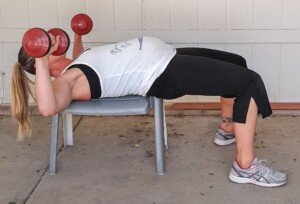
Allie Edwards demonstrates. She is a CPT specializing in prenatal and postpartum fitness, and endorses strength training exercises for expectant women.
Bring the weights down so that your upper arms are at least parallel to the floor.
It’s okay to go beyond parallel a little bit so that the dumbbells are aligned with your chest.
Press them upward so that your arms are straight.
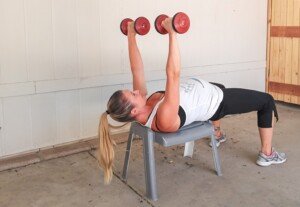
Hand position can either be palms facing forward or towards each other.
These two positions can also be fused, so that at the beginning, your palms are facing forward, and then at the top of the movement, they’re facing each other.
Do 12 to 15 repetitions. If this doesn’t feel challenging, use a heavier pair of dumbbells.
Main muscles worked: chest, shoulders and triceps.
Dumbbell Press – Inclined
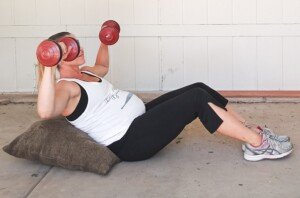
Repeat the above movement except this time, you’re lying on an angled surface such as a common sofa pillow.
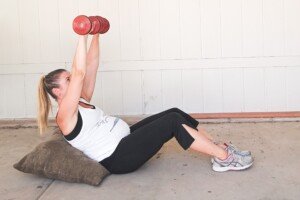
A wedge pillow will work even better, as it retains its form when you lie on it, and there’s also room to rest your head.
Seated Row
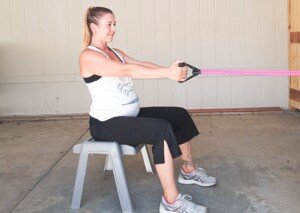
Loop a tension band around a secure anchor.
Set up a chair or fitness ball at a distance from the anchor point so that it requires a challenge to pull the handles of the band towards your chest.
Keep your upper body vertical with an arch in your lower back.
Palms may be facing upwards, towards each other or towards the floor.
Keep your upper arms against your sides. Do not flare them out.
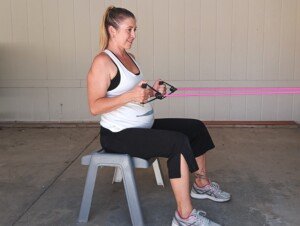
Do 12 to 15 repetitions. If this wasn’t challenging, set the seat further away to create more resistance in the band.
Main muscles worked: back, biceps, forearms.
Kettlebell Swing
Position yourself as shown below.
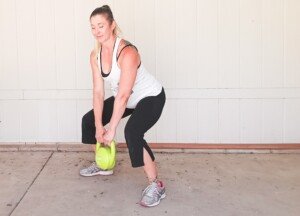
Make sure there’s always an arch in your lower back. Never let your back round.
Swing the weight upward. You can go all the way up, as shown, or, stop when your arms are parallel to the floor.
Reverse the motion with control.
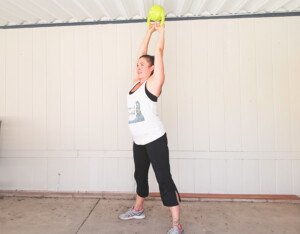
Do eight to 10 repetitions for the first several sessions, then increase it to 12 to 15. Aim for 20 reps eventually.
Main muscles worked: low back, middle back and upper legs.
Squat
You can use a kettlebell or dumbbells.
Start the exercise as shown below. It’s safe if you can get your thighs parallel to the floor.
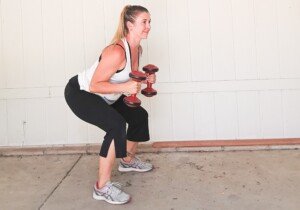
The wider the feet are placed apart, the easier it is to sink into the squat.
But do not let your thighs go past parallel to the floor.
Additionally, the wider your feet are apart, the more you should point your feet outward.
Always keeping your lower back arched, rise so that your legs are straightened.
Do eight to 12 repetitions. If this was easy, try a heavier weight.
Variation: Holding the dumbbells at your sides. A kettlebell should be held at chest level.
Main muscles worked: legs and butt.
[mv_create key=”7″ layout=”hero” thumbnail=”false” title=”3 Strength Training Tips” type=”list”]
Sets and Resting in Between
You should do at least three sets per exercise, but the number of sets per exercise do not have to be the same.
For example, you can do six sets of the squats and five sets of the rows.
The rest time in between sets can range from 60 to 90 seconds.
Take the time you need in between each particular exercise, but for structure, aim for two to three minutes.
This safe strength training routine can be done twice a week.
Pregnant women who are new to strength training can obtain exercise guidelines from their OBGYN.
The guidelines will vary depending on trimester. Make sure your OBGYN clears you for strength training.

 Allie Edwards runs two blogs:
Allie Edwards runs two blogs: 











